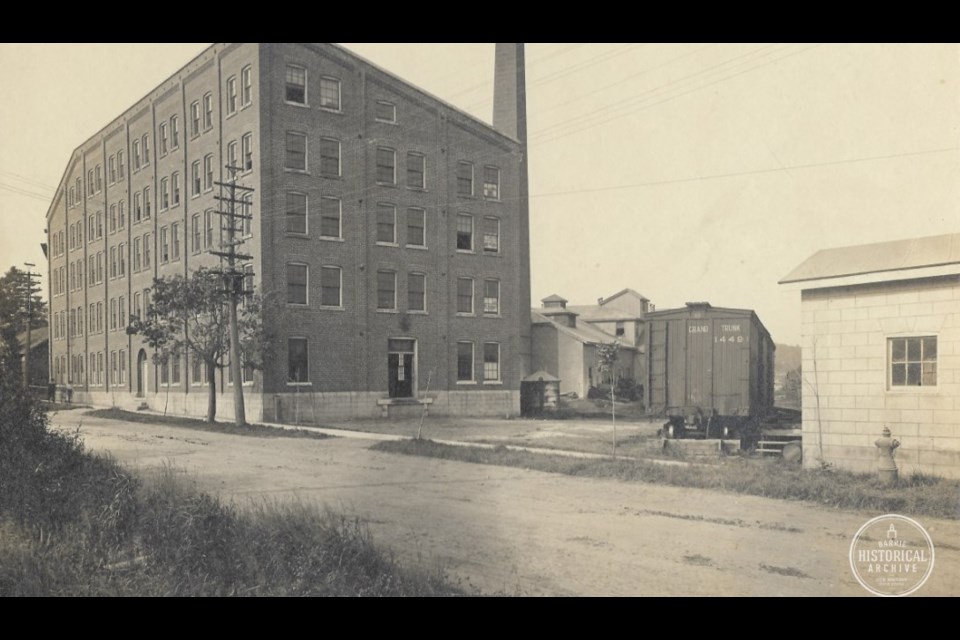My stories arise in a number of ways. Sometimes, as I am digging through old Barrie newspapers to find information on a particular topic, a tantalizing headline appears in an adjoining column. I scribble it down in one of my many notebooks and revisit it another day.
Another spark for tales of Barrie’s fascinating past comes from questions. Just this week, I was asked about a tragic event that occurred in our community in 1957, and so this story was born. At the end of this article, you will find I have a question of my own for you.
Known simply as ‘the tannery’ to most, this great edifice with the giant smoke stack stood on Bradford Street, just across from the old Prince of Wales school. Former students well remember the strong odours that emanated from the leather processing plant.
This tannery was not the first in Barrie. Andrew Graham arrived in Barrie in the 1830s and operated a boot and shoe shop from his home on Dunlop Street East. By the 1850s, he had opened a large leather tannery just across the street.
The Barrie Tanning Company began its Bradford Street days in 1900. The company had its roots in the old Graham tannery, which had passed through several hands over the years. As the 20th century dawned, it was apparent a new and modern tannery would be required.
In December 1900, the chimney was completed. The Northern Advance reported it stood 125 feet high and was made from 270 tons of bricks and mortar. At that time, the building exterior was nearly complete, but it would take another 10 months before the machinery was sufficiently ordered, installed and tested to allow work to begin. A public grand opening was held Sept. 26, 1901.
The new, five-storey tannery was a welcome thing in Barrie. It created plenty of jobs in a town that was eager to put itself on the manufacturing map.
As with any heavy industry, there are hazards. The tannery on Bradford Street was no exception as reports of lost limbs, near-deaths and permanently disabled workmen often appeared in the local newspapers. Perhaps the most well remembered of these unpleasant happenings occurred in May 1957.
Just before midnight on Sunday, May 5, the tannery's boiler house exploded. It sent bricks flying in all directions and hundreds of windows were broken in the factory itself, and also across the street at the General Electric plant. The metal pipe that had connected the boiler house to the chimney stack was found lying next to the railway tracks.
In this pile of brick, twisted metal and wooden beams, two men were believed to have been working. The police and fire departments were quickly on scene and the first workman taken out of the wreckage was Cecil Dunnett, a 35-year-old stationary engineer. He was barely conscious, but managed to point to the last known location of his co-worker, Fred Weeks.
Weeks was the engineer on shift in the boiler house, which contained three boilers used for creating steam for both heating and processing purposes. Volunteers showed up from everywhere to aid in the search.
By the spotlight of the fire engine, they lifted bricks by hand and wheelbarrowed them away. A bulldozer was brought in and Weeks was found a few hours later. Sadly, he was deceased. Dunnett survived for a few days, but then also succumbed to his injuries.
When the terrible accident occurred, the tanning industry had been experiencing a bit of a slowdown and tannery employees had recently been on a four-day work week schedule. Even so, the Barrie Tanning Company had to keep going.
One boiler had been destroyed and the others knocked off their foundations by the blast. To resume manufacturing, the Barrie Tanning Company rented a locomotive engine from the CNR at Allandale. In the late 1950s, steam engines were fast becoming a thing of the past, so this locomotive was easily spared.
My question for you is this: Did this locomotive become a permanent working fixture in the tannery boiler house, or was it replaced later on with a new boiler? My source had heard the boiler house was repaired and rebricked with the locomotive still inside.
Each week, the Barrie Historical Archive provides BarrieToday readers with a glimpse of the city’s past. This unique column features photos and stories from years gone by and is sure to appeal to the historian in each of us.



